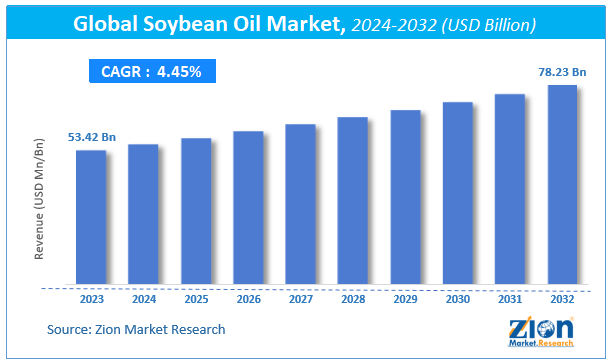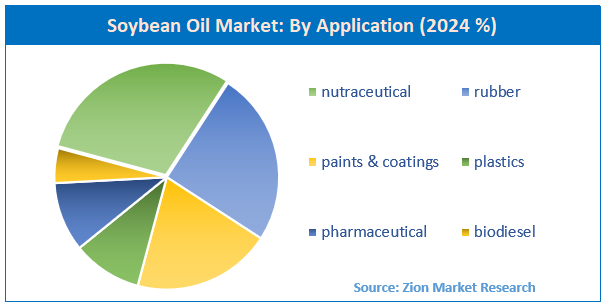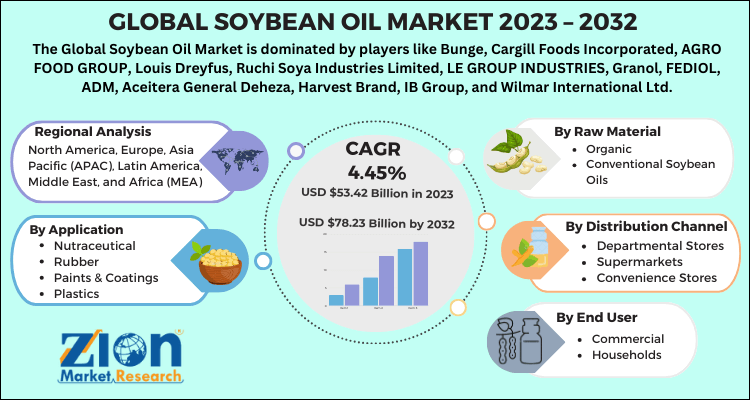Soybean Oil Market Growth, Size, Share, Trends, and Forecast 2032

Soybean Oil Market By Raw material (organic and conventional soybean oils), By Application (nutraceutical, rubber, paints & coatings, plastics, pharmaceutical, and biodiesel), By Distribution channel (departmental stores, supermarkets, convenience stores, and hypermarkets), By End-use (commercial and households) And By Region: - Global And Regional Industry Overview, Market Intelligence, Comprehensive Analysis, Historical Data, And Forecasts, 2024-2032ustry Overview, Market Intelligence, Comprehensive Analysis, Historical Data, And Forecasts, 2024-2032
| Market Size in 2023 | Market Forecast in 2032 | Growth Rate (in %) | Base Year |
|---|---|---|---|
| USD 53.42 Billion | USD 78.23 Billion | CAGR at 4.45% | 2023 |
Description
According to the report published by Zion Market Research, the global Soybean Oil Market size was valued at USD 53.42 Billion in 2023 and is predicted to reach USD 78.23 Billion by the end of 2032. The market is expected to grow with a CAGR of 4.45% during the forecast period. The report analyzes the global Soybean Oil Market’s growth drivers, restraints, and impact on demand during the forecast period. It will also help navigate and explore the arising opportunities in the Soybean Oil Market industry.
Key Insights
- As per the analysis shared by our research analyst, the soybean oil market is anticipated to grow at a CAGR of 4.45% during the forecast period (2024-2032).
- The global soybean oil market was estimated to be worth approximately USD 53.42 billion in 2023 and is projected to reach a value of USD 78.23 billion by 2032.
- The growth of the soybean oil market is being driven by rising consumer awareness of healthy eating habits and the growing demand for plant-based oils are supporting market expansion.
- Based on the raw material, the organic segment is growing at a high rate and is projected to dominate the market.
- On the basis of application, the nutraceutical segment is projected to swipe the largest market share.
- In terms of distribution channel, the departmental stores segment is expected to dominate the market.
- Based on the end-use, the commercial segment is expected to dominate the market.
- By region, North America is expected to dominate the global market during the forecast period.
Global Soybean Oil Market: Overview
Soybean oil finds massive application in household cooking activities as well as restaurants. The oil is used in preparing of margarine and shortenings. The product has become popular due to its emulsification property as well as low-calorie contents. The soybean oil does not comprise of trans-fat and has low saturated fats, thereby making it a major choice among other types of oils.
It is considered to be one of the best cooking oils good for health due to the presence of the key ingredients such as omega-3 fats, vitamin E, low saturated fats, and polyunsaturated fats in the product.
Global Soybean Oil Market: Growth Factors
The soybean oil industry is projected to experience a lucrative surge over the ensuing years due to escalating food demand, inflating population, expansion of the retail network, swift urbanization, and rising soy crop harvest. Apart from this, the product offers massive health benefits such as reducing levels of cholesterol & obesity, raising the levels of immunity, minimizing cognitive & cardiac diseases, and preventing osteoporosis. Additionally, the product also finds myriad application in industrial paints, adhesives, biocomposites, oleochemicals, cleaners, biodiesel, and solvents. Nonetheless, easy availability of the product substitutes including olive oil, sunflower oil, palm oil, rapeseed oil, and rice bran is predicted to inhibit the market demand in the near future. However, the rise in the number of health-conscious customers will generate huge demand for the product, thereby creating lucrative growth avenues for the soybean oil market in the upcoming years.
Moreover, the high lipid contents of soybean oil along with its lubricating features make its application an ideal choice in fermentation & drilling process. In addition to this, low product costs, easy availability, and eco-friendly characteristics make it a key part of bio-based items.
Global Soybean Oil Market: Segmentation
The overall soybean oil market can be classified based on raw material, application, distribution channel and end-use.
Based on the Raw Material, the industry is segregated into organic and conventional soybean oils.
Application Wise, the market is divided into nutraceutical, rubber, paints & coatings, plastics, pharmaceutical, and biodiesel.
On the basis of the Distribution Channel, the market for soybean oil is sectored into departmental stores, supermarkets, convenience stores, and hypermarkets.
In terms of End-Use, the industry is segmented into commercial and households.
Recent Development
- In May 2025, Resinall and Azelis launched a plant-based alternative to tall oil fatty acid (TOFA), marking a significant step toward sustainable chemistry. Derived from soy, this innovation minimizes dependence on fossil and pine-based materials while maintaining high performance in lubricants, alkyd resins, and adhesives.
- In July 2024, Louis Dreyfus Company (LDC) relaunched its Vibhor edible oil brand in India, featuring a refreshed range including fortified Refined Soybean Oil with Vitamins A & D. By expanding this enhanced portfolio, LDC aims to reach health-conscious consumers across India by 2026.
- In November 2023, ADM and Marathon Petroleum Corp. celebrated the launch of Green Bison Soy Processing, a new joint venture in Spiritwood. As North Dakota's first dedicated soybean processing plant, Green Bison represents a strategic response to the growing demand for renewable green diesel, marking a significant step forward in the future of sustainable energy.
Soybean Oil Market : Report Scope
| Report Attributes | Report Details |
|---|---|
| Report Name | Soybean Oil Market Research Report |
| Market Size in 2023 | USD 53.42 Billion |
| Market Forecast in 2032 | USD 78.23 Billion |
| Growth Rate | CAGR of 4.45% |
| Number of Pages | 201 |
| Key Companies Covered | Bunge, Cargill Foods Incorporated, AGRO FOOD GROUP, Louis Dreyfus, Ruchi Soya Industries Limited, LE GROUP INDUSTRIES, Granol, FEDIOL, ADM, Aceitera General Deheza, Harvest Brand, IB Group, and Wilmar International Ltd. |
| Segments Covered | By Raw material, By Application, By Distribution channel, By End-use and By Region |
| Regions Covered | North America, Europe, Asia Pacific (APAC), Latin America, Middle East, and Africa (MEA) |
| Base Year | 2023 |
| Historical Year | 2018 to 2022 |
| Forecast Year | 2024 - 2032 |
| Customization Scope | Avail customized purchase options to meet your exact research needs. Request For Customization |
Soybean Oil Market Dynamics
Key Growth Drivers
The Soybean Oil Market is experiencing strong growth, primarily driven by its versatility and widespread use in both food and non-food applications. As a staple edible oil, it is a preferred choice for cooking, frying, and baking due to its neutral flavor, high smoke point, and affordability. The expanding food service and processed food industries, particularly in fast-growing economies in Asia, are major consumers. Furthermore, the burgeoning biodiesel industry is a significant catalyst. With governments worldwide implementing mandates and incentives to reduce carbon emissions and promote renewable energy, soybean oil is increasingly being used as a key feedstock for biodiesel production, creating a robust new source of demand.
Restraints
Despite its strong position, the soybean oil market faces several significant restraints. One of the main challenges is the intense competition from alternative vegetable oils like palm oil, sunflower oil, and canola oil, which can be more cost-effective or have different functional properties for specific applications. The market is also highly susceptible to fluctuations in commodity prices, which are influenced by a variety of factors including weather patterns, crop yields, and global trade policies. This volatility can make it difficult for manufacturers and end-users to manage costs and can lead to market uncertainty. Additionally, concerns about the environmental impact of large-scale soybean farming, particularly deforestation, can lead to consumer and regulatory pressure, which may restrain growth.
Opportunities
The soybean oil market is ripe with opportunities for innovation and expansion. The increasing consumer focus on health and wellness is creating a strong demand for specialized, high-oleic soybean oils with enhanced nutritional profiles and a longer shelf life, which can be used to produce trans fat-free foods. The growth of the bio-based sector presents an opportunity for soybean oil to be used in new industrial applications, such as lubricants, paints, plastics, and adhesives, as a sustainable alternative to petroleum-based products. The expansion of the market into new geographic regions, particularly in Asia-Pacific where rising incomes and urbanization are changing dietary habits, also offers a significant growth avenue for market players.
Challenges
The soybean oil market faces several critical challenges that must be addressed for sustained growth. A major challenge is the complex and interconnected supply chain, which is vulnerable to disruptions from geopolitical events, trade tensions, and logistical bottlenecks. The market is also challenged by the lack of a universal standardization in terms of quality and sustainability certifications, which can create confusion for consumers and complicate international trade. Furthermore, the need to meet the dual demand from the food and biofuel industries can create supply and demand imbalances, leading to price volatility and ethical concerns about using a food crop for fuel.
Global Soybean Oil Market: Regional Analysis
Based on regions, the overall soybean oil market can be divided into five main regions: Europe, Asia Pacific, North America, Latin America, and the Middle East and Africa. Regionally, Asia Pacific is projected to make lucrative contributions towards the overall market growth during the estimated timeline. The regional growth can be credited to escalating demand for soybean oil for cooking purpose in households as well as in the fast-food sector. Moreover, inflating urban populace & rise in the number of health-conscious customers in countries like India, Japan, and China will proliferate product penetration in the Asia Pacific region.
Furthermore, the North American market is slated to witness a humungous surge over the forthcoming years due to the presence of countries like the U.S., a leading soybean oil producer in the region.
Global Soybean Oil Market: Competitive Players
Some of the key players in soybean oil industry include:
- Bunge
- Cargill Foods Incorporated
- AGRO FOOD GROUP
- Louis Dreyfus
- Ruchi Soya Industries Limited
- LE GROUP INDUSTRIES
- Granol
- FEDIOL
- ADM
- Aceitera General Deheza
- Harvest Brand
- IB Group
- Wilmar International Ltd.
The Global Soybean Oil Market is segmented as follows:
By Raw material
- Organic
- Conventional Soybean Oils
By Application
- Nutraceutical
- Rubber
- Paints & Coatings
- Plastics
- Pharmaceutical
- Biodiesel
By Distribution channel
- Departmental stores
- Supermarkets
- Convenience stores
- Hypermarkets
By End-use
- Commercial
- Households
Global Soybean Oil Market: Regional Segment Analysis
- North America
- The U.S.
- Europe
- The UK
- France
- Germany
- The Asia Pacific
- China
- Japan
- India
- Latin America
- Brazil
- The Middle East and Africa
What Reports Provides
- Full in-depth analysis of the parent market
- Important changes in market dynamics
- Segmentation details of the market
- Former, on-going, and projected market analysis in terms of volume and value
- Assessment of niche industry developments
- Market share analysis
- Key strategies of major players
- Emerging segments and regional markets
- Testimonials to companies in order to fortify their foothold in the market.
Table Of Content
FrequentlyAsked Questions
Based on statistics from the Zion Market Research, the global Soybean Oil Market size was projected at approximately US$ 53.42 Billion in 2023. Projections indicate that the market is expected to reach around US$ 78.23 Billion in revenue by 2032.
The global Soybean Oil Market is expected to grow at a Compound Annual Growth Rate (CAGR) of around 4.45% during the forecast period from 2024 to 2032.
North America is expected to dominate the global Soybean Oil Market.
The global Soybean Oil Market is driven by several key factors such as; rising demand for fresh and organic produce, population growth, and health-conscious consumer preferences.
Some of the prominent players operating in the global Soybean Oil Market are; Bunge, Cargill Foods Incorporated, AGRO FOOD GROUP, Louis Dreyfus, Ruchi Soya Industries Limited, LE GROUP INDUSTRIES, Granol, FEDIOL, ADM, Aceitera General Deheza, Harvest Brand, IB Group, and Wilmar International Ltd.
The global Soybean Oil Market report provides a comprehensive analysis of market definitions, growth factors, opportunities, challenges, geographic trends, and competitive dynamics.
HappyClients
Zion Market Research
Tel: +1 (302) 444-0166
USA/Canada Toll Free No.+1 (855) 465-4651
3rd Floor,
Mrunal Paradise, Opp Maharaja Hotel,
Pimple Gurav, Pune 411061,
Maharashtra, India
Phone No +91 7768 006 007, +91 7768 006 008
US OFFICE NO +1 (302) 444-0166
US/CAN TOLL FREE +1 (855) 465-4651
Email: sales@zionmarketresearch.com
We have secured system to process your transaction.
Our support available to help you 24 hours a day, five days a week.
Monday - Friday: 9AM - 6PM
Saturday - Sunday: Closed







